Ever thought about removing your acrylic nails at home instead of going to the salon? It’s possible to do it safely and effectively. We’ll show you how to remove acrylic nails without harming your natural nails.
Removing acrylic nails can be tricky, but it’s doable with the right steps. If you’re short on time or like doing things yourself, learning to remove them at home can be a big help. We’ll walk you through the process, from using acetone to gentle filing.
Key Takeaways
- Removing acrylic nails at home is possible with proper techniques
- Acetone is the most common method for acrylic nail removal
- Alternative methods exist for those sensitive to acetone
- Proper preparation is crucial for a safe removal process
- Aftercare is essential to maintain natural nail health
Understanding Acrylic Nails and Removal Challenges
Acrylic nails are a big trend in beauty, but removing them safely is key. We’ll explore what acrylic nails are and why getting them removed by a pro is best.
What are acrylic nails?
Acrylic nails are fake nail enhancements made from a liquid monomer and powder polymer mix. This combo creates a strong, plastic-like layer over your natural nails. They’re loved for their durability and versatility.
Why professional removal is recommended
Getting your acrylics removed by a pro is wise because of their strong adhesive. Nail techs have the right tools and know-how to remove them safely. They use special methods to protect your natural nails and keep them healthy.
Risks of improper removal
Removing acrylics the wrong way can cause problems:
- Nail damage: The wrong removal can make your natural nails thin, brittle, or even fall off.
- Skin irritation: DIY removal with harsh chemicals can irritate your skin.
- Infection: Bad removal methods can let bacteria in, causing infections.
Knowing these risks is important when thinking about how to remove acrylic nails. While going to a pro is safest, learning to do it at home can be useful for emergencies or between salon visits.
| Removal Method | Pros | Cons |
|---|---|---|
| Professional | Safest, least damaging | Costly, time-consuming |
| DIY Acetone Soak | Affordable, effective | Time-consuming, potential skin irritation |
| Non-Acetone Methods | Gentler on skin and nails | Less effective, may take longer |
Preparing for DIY Acrylic Nail Removal
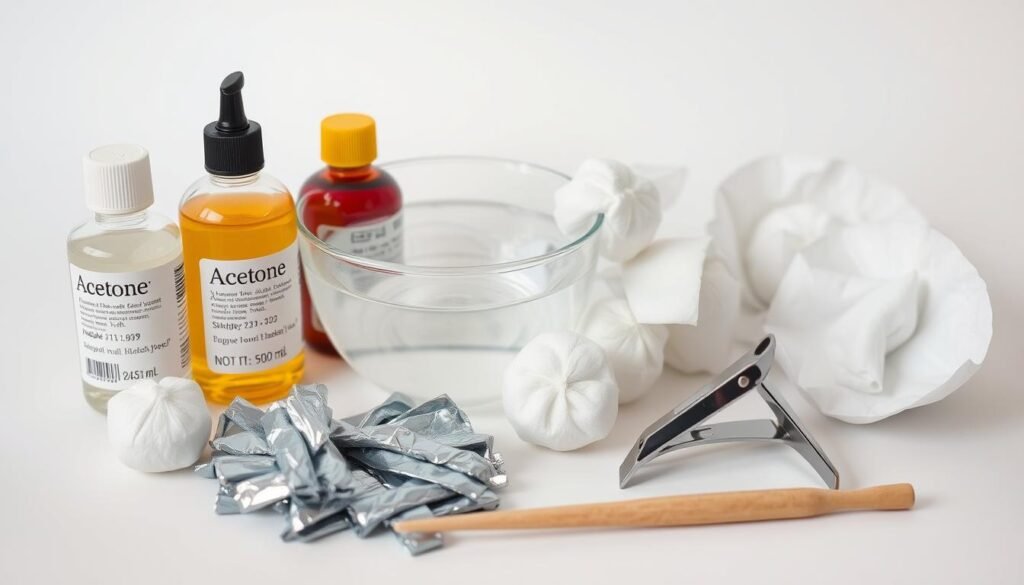
Before you begin removing your acrylic nails, it’s important to get the right tools and prep your nails. This makes the process smoother and protects your natural nails.
Gathering necessary tools and materials
To safely remove your acrylics, you’ll need specific tools. Here’s a list of what you’ll need:
- Nail clippers
- Coarse nail file
- Acetone or non-acetone nail polish remover
- Petroleum jelly
- Cotton balls
- Aluminum foil
- Orange stick or cuticle pusher
Trimming and filing acrylic nails
Begin by trimming your acrylic nails as short as you can with nail clippers. Next, file down the acrylics. Use a coarse nail file to roughen the surface of each nail. This makes it easier for the acetone to work.
Protecting your skin and cuticles
Apply a thick layer of petroleum jelly around your nails and on your fingertips. This barrier stops the harsh acetone from drying out and irritating your skin during the removal.
| Step | Action | Purpose |
|---|---|---|
| 1 | Gather tools | Ensure you have all necessary items |
| 2 | Trim nails | Reduce acrylic length for easier removal |
| 3 | File nail surface | Increase acetone penetration |
| 4 | Apply petroleum jelly | Protect skin from acetone |
How to Remove Acrylic Nails: Step-by-Step Guide
https://www.youtube.com/watch?v=zFJG8EIabrQ
Ready to soak off your acrylic nails? Follow this easy guide to do it safely at home. The acetone method is a favorite and works well.
- Saturate cotton balls with acetone for removing acrylics.
- Place cotton balls on each nail.
- Wrap fingertips in aluminum foil.
- Let nails soak for 20-30 minutes.
- Gently push off softened acrylic with a cuticle pusher.
- If resistant, continue soaking.
- Buff nails to smooth the surface.
- Wash hands thoroughly.
For quicker results, try using a heating pad under the acetone bowl. This can speed up the process by softening the acrylic faster.
| Step | Time | Tips |
|---|---|---|
| Soak nails | 20-30 minutes | Use pure acetone for best results |
| Remove acrylic | 5-10 minutes | Be gentle to avoid nail damage |
| Buff and clean | 5 minutes | Use a fine-grit buffer for smoothness |
Remember, patience is key when you soak off acrylic nails. Rushing the process can damage your natural nails. Take breaks if needed and keep your hands moisturized after removal.
Alternative Methods for Removing Acrylic Nails
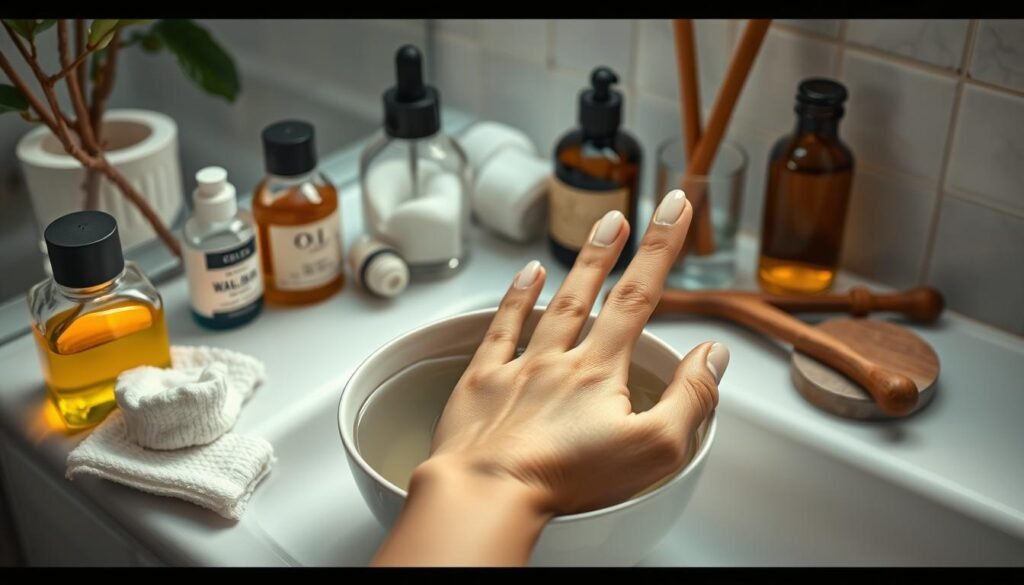
If you want to remove acrylic nails without harming your natural nails, there are home methods you can try. These gentler techniques can help protect your nails during the process.
Non-Acetone Nail Polish Remover
Non-acetone nail polish remover is a milder choice for acrylic removal. It might take longer than acetone, but it’s gentler on your nails and skin. Soak your nails in the remover for 30-40 minutes. Then, use a wooden cuticle stick to gently remove the loosened acrylic.
Warm Water and Soap Technique
For a chemical-free method, try soaking your nails in warm, soapy water. Soak for 30-40 minutes to loosen the acrylic. After soaking, use a nail file to carefully scrape off the acrylic.
Dental Floss for Grown-Out Acrylics
If your acrylics have grown out a lot, dental floss can help remove them. This works best when the acrylics are already loose. Slide the floss under the acrylic edge and gently move it back and forth to lift the nail.
| Method | Time Required | Effectiveness | Risk of Damage |
|---|---|---|---|
| Non-Acetone Remover | 60-90 minutes | Moderate | Low |
| Warm Water and Soap | 30-40 minutes | Low to Moderate | Very Low |
| Dental Floss | 10-15 minutes | High (for grown-out acrylics) | Moderate |
Removing acrylics at home requires patience. If you feel pain or resistance, stop. It’s safer to seek professional help to avoid harming your natural nails.
Conclusion: Aftercare and Nail Health Tips
Removing acrylic nails can be hard on your nails. After it’s done, your nails need some care. Start by gently buffing your nails with a glass file to smooth out any rough spots. This helps remove leftover residue and preps your nails for the next steps.
Nourishing your nail beds is key after removal. Apply cuticle oil regularly to hydrate and strengthen the area around your nails. Also, use a rich hand cream to combat any dryness caused by the acrylic nail removal process. Your hands will thank you for the extra moisture.
To protect your newly exposed nails, consider using a hand cream with SPF. This shields your hands from UV damage, which can weaken nails over time. By following these aftercare tips, you’ll help your nails recover faster and stay healthier, whether you plan to go natural or prep for your next set of acrylics.
FAQ
What are acrylic nails?
Why is professional removal recommended?
What tools and materials are needed for DIY acrylic nail removal?
How do you remove acrylic nails using the acetone soak-off method?
What alternative methods can be used for removing acrylic nails?
What aftercare steps are important for nail health after removing acrylic nails?
Source Links
- How to Remove Acrylics at Home Without Destroying Your Natural Nails – https://www.allure.com/story/how-to-remove-acrylic-nails
- How To Remove Acrylic Nails Without Damage – L’Oréal Paris – https://www.lorealparisusa.com/beauty-magazine/beauty-tips/beauty-looks/how-to-remove-acrylic-nails-at-home
- Ways to Remove Acrylic Nails Without Acetone at Home – Tips and Tricks – https://falseeyelashes.co.uk/blogs/news/ways-to-remove-acrylic-nails-without-acetone-at-home?srsltid=AfmBOoq6VE0uN7iyFXGjN-_4Mh3RpbyyXrz94TimpIo8Ai6MrnC-zS8o

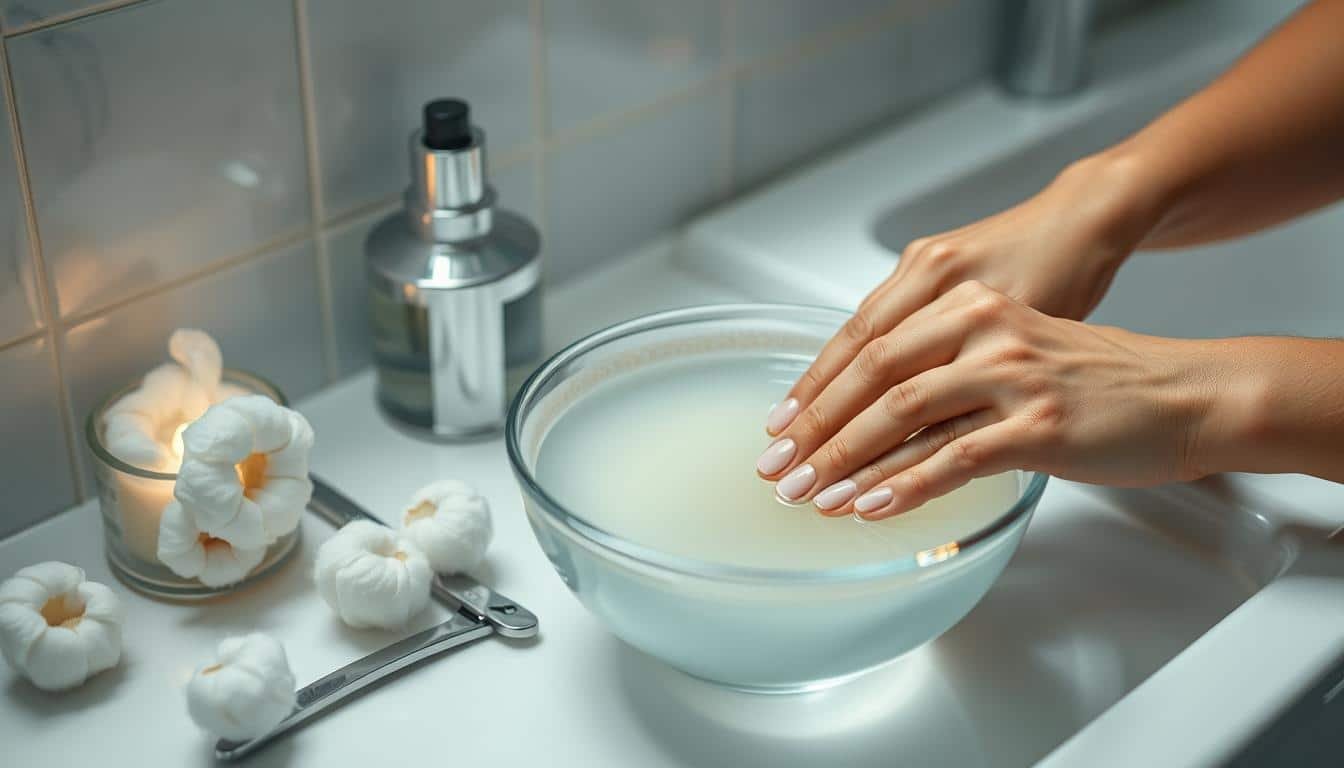



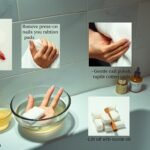
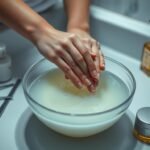

Interesting read but isnt suggesting at-home removal of acrylic nails a bit risky? Why not leave it to the professionals? Just a thought.
While I appreciate the info, I disagree. Ive removed acrylics at home plenty of times without any trouble. Is professional removal really necessary?
Not all experiences are universal. What works for you might damage others nails. Professional removal is safer.
Interesting article, but honestly, why risk damaging your nails at home when professional removal is safer and not that expensive? Just my two cents.
Not everyone has the budget or time for professional removal, Karen. Its about options.
I think were ignoring the elephant in the room here, guys. Why spend so much on acrylics only to DIY the removal? 🤷♀️💅
Interesting read but honestly, why not just leave it to professionals? Are we all trying to be nail technicians now?
Interesting read, but honestly, why risk home removal? Arent we just better off leaving it to the pros? #JustSaying
Interesting read, but why not innovate more? Why not a DIY edible nail polish remover? Just a crazy thought!
I get the professional removal bit, but isnt there a safer DIY method? Cant be paying salon prices all the time!